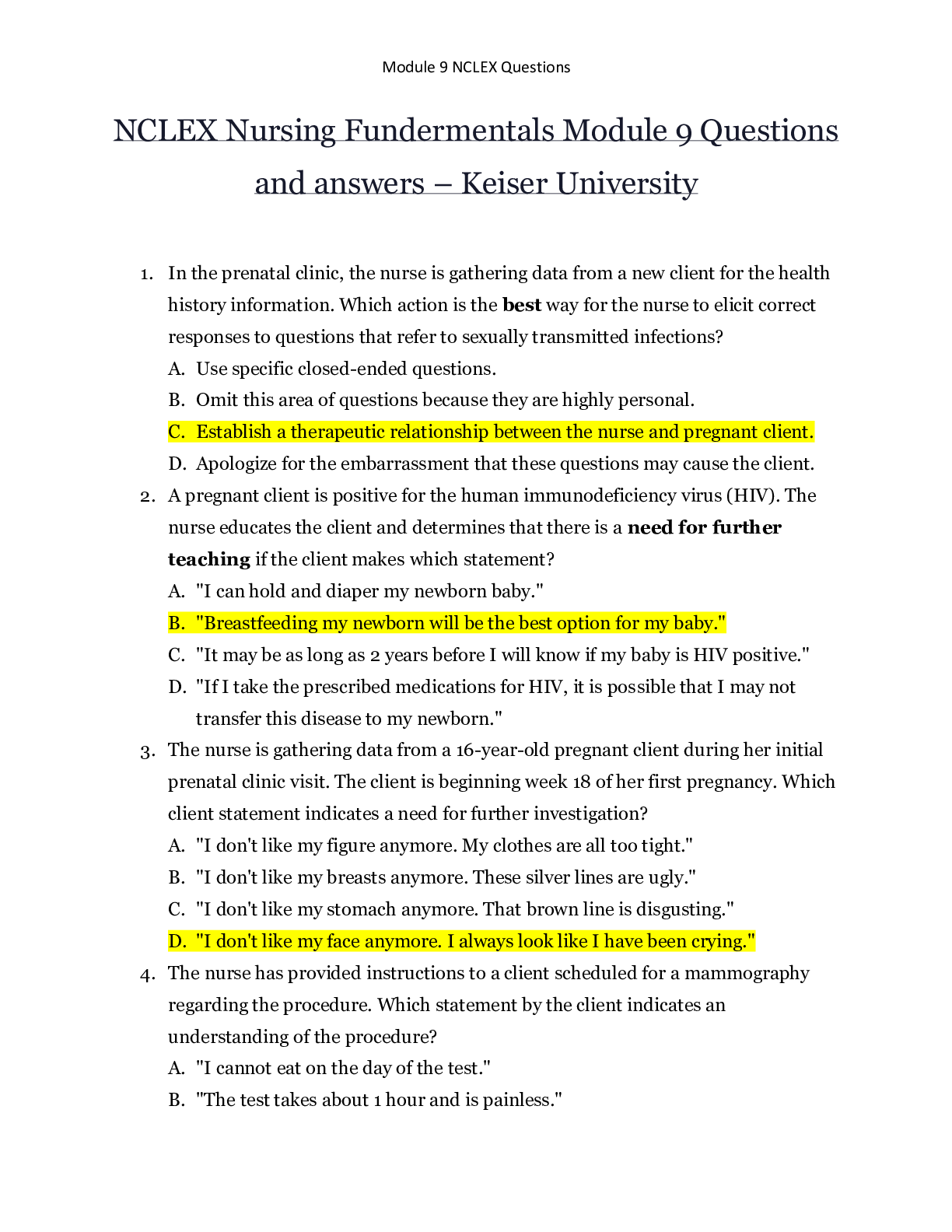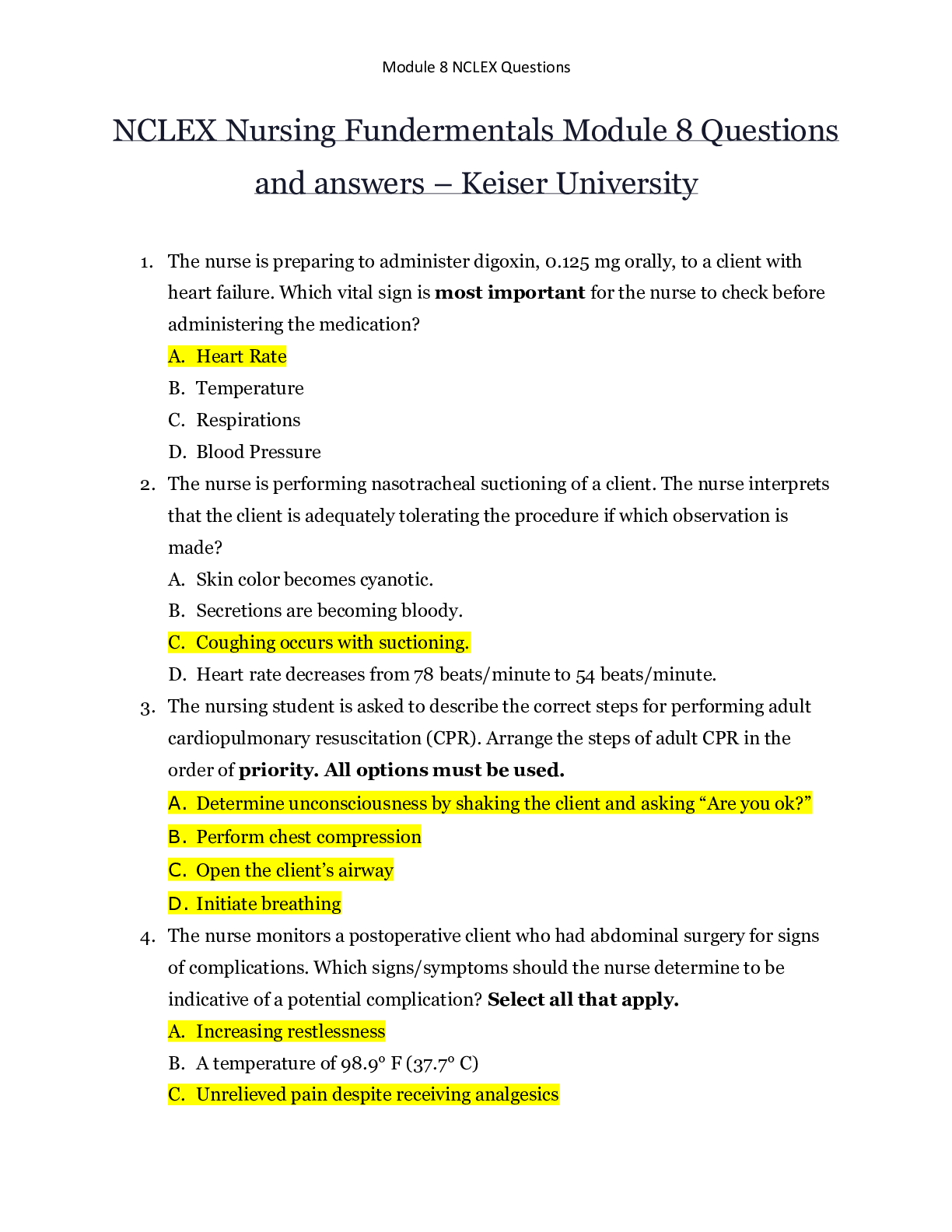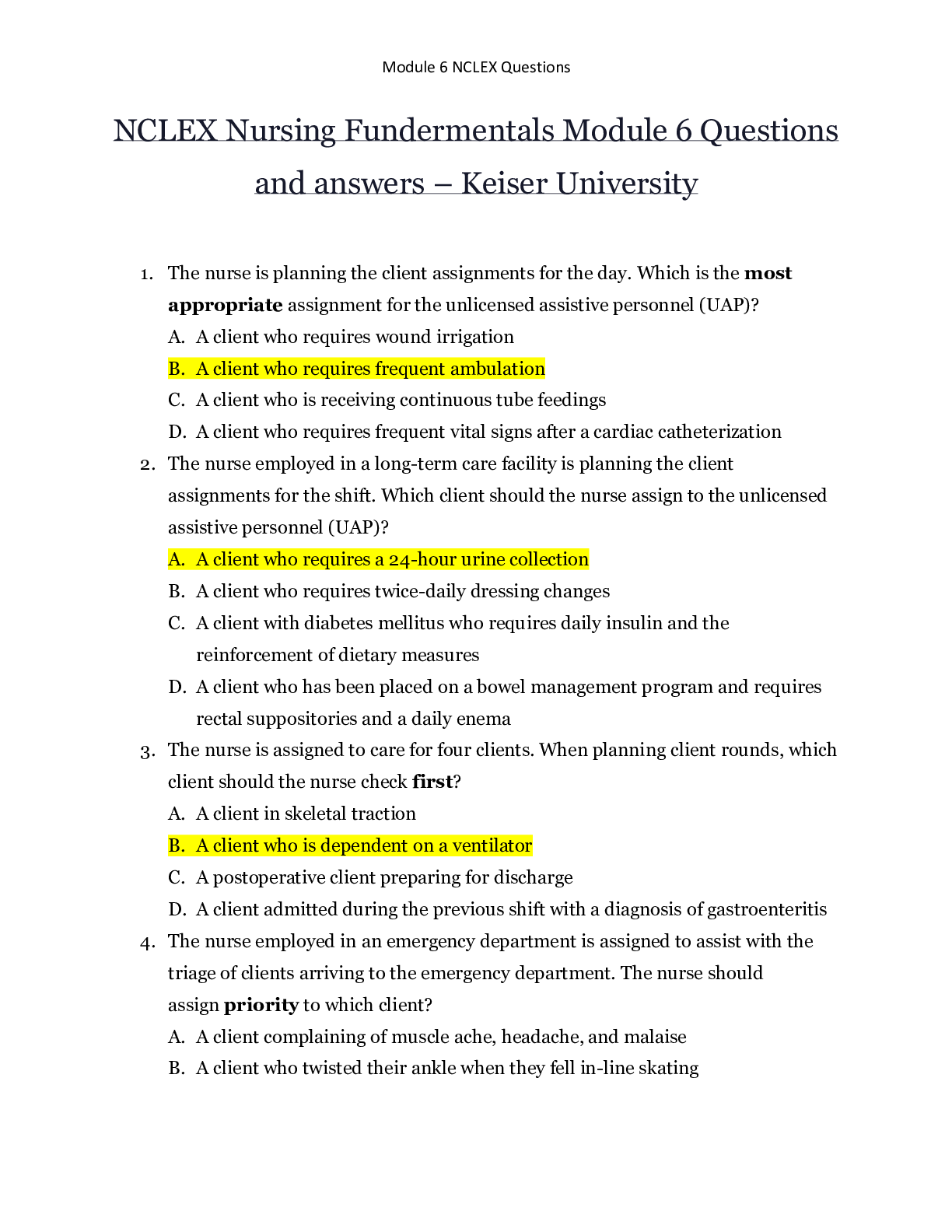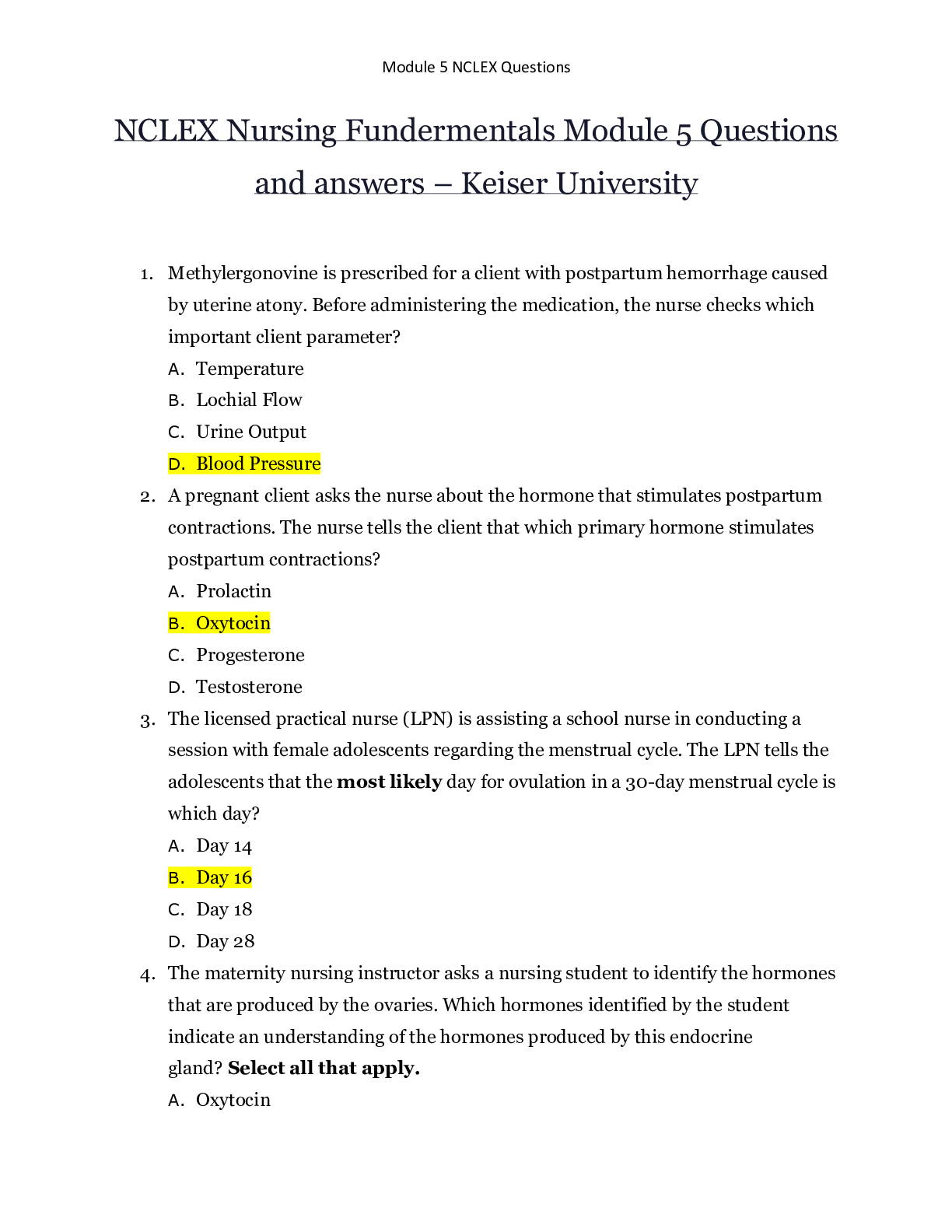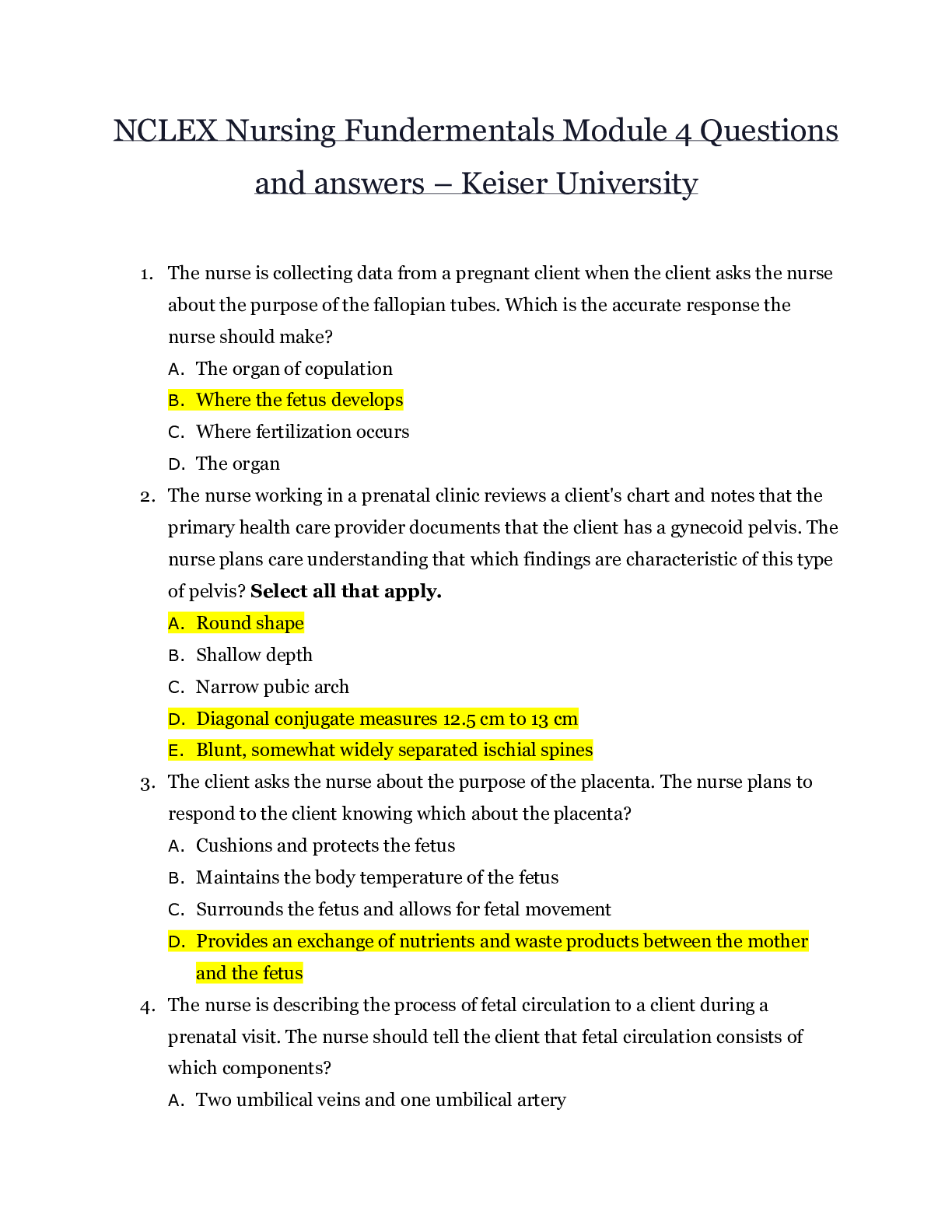*NURSING > NCLEX-RN > NUR 4940 NCLEX_Questions_MEDICAL_SURGICAL_NURSING - Florida International University | Respiratory S (All)
NUR 4940 NCLEX_Questions_MEDICAL_SURGICAL_NURSING - Florida International University | Respiratory System
Document Content and Description Below
NUR 4940 NCLEX_Questions_MEDICAL_SURGICAL_NURSING - Florida International University NUR 4940 NCLEX_Questions_MEDICAL_SURGICAL_NURSING - Respiratory System MEDICAL SURGICAL NURSING RESPIRATORY SY... STEM: 1. List 4 common symptoms of pneumonia the nurse might note on a physical exam. 2. State 4 nursing interventions for assisting the client to cough productively. 3. What symptoms of pneumonia might the nurse expect to see in an older client? 4. What should the O2 flow rate be for the client with COPD? 5. How does the nurse prevent hypoxia during suctioning? 6. During mechanical ventilation, what are three major nursing intervention? 7. When examining a client with emphysema, what physical findings is the nurse likely to see? 8. What is the most common risk factor associated with lung cancer? - Smoking 9. Describe the pre-op nursing care for a client undergoing a laryngectomy. 10. List 5 nursing interventions after chest tube insertion. 11. What immediate action should the nurse take when a chest tube becomes disconnected from a bottle or a suction apparatus? What should the nurse do if a chest tube is accidentally removed from the client? 12. What instructions should be given to a client following radiation therapy? 13. What precautions are required for clients with TB when placed on respiratory isolation? 14. List 4 components of teaching for the client with tuberculosis. RENAL SYSTEM: 1. Differentiate between acute renal failure and chronic renal failure. 2. During the oliguric phase of renal failure, protein should be severely restricted. What is the rationale for this restriction? 3. Identify 2 nursing interventions for the client on hemodialysis. 4. What is the highest priority nursing diagnosis for clients in any type of renal failure? 5. A client in renal failure asks why he is being given antacids. How should the nurse reply? 6. List 4 essential elements of a teaching plan for clients with frequent urinary tract infections. 7. What are the most important nursing interventions for clients with possible renal calculi? 8. What discharge instructions should be given to a client who has had urinary calculi? 9. Following transurethral resection of the prostate gland (TURP), hematuria should subside by what post-op day? 10. After the urinary catheter is removed in the TURP client, what are 3 priority nursing actions? 11. After kidney surgery, what are the primary assessments the nurse should make? CARDIOVASCULAR SYSTEM: 1. How do clients experiencing angina describe that pain? 2. Develop a teaching plan for the client taking nitroglycerin. 3. List the parameters of blood pressure for diagnosing hypertension. 4. Differentiate between essential and secondary hypertension. 5. Develop a teaching plan for the client taking antihypertensive medications. 6. Describe intermittent claudication. 7. Describe the nurse’s discharge instructions to a client with venous peripheral vascular disease. 8. What is often the underlying cause of abdominal aortic aneurysm? 9. What lab values should be monitored daily for the client with thrombophlebitis who is undergoing anticoagulant therapy? 10. When do PVCs (premature ventricular contractions) present a grave danger? 11. Differentiate between the symptoms of left-sided cardiac failure and right-sided cardiac failure. 12. List 3 symptoms of digitalis toxicity. 13. What condition increases the likelihood of digitalis toxicity occurring? 14. What life style changes can the client who is at risk for hypertension initiate to reduce the likelihood of becoming hypertensive? 15. What immediate actions should the nurse implement when a client is having a myocardial infarction? 16. What symptoms should the nurse expect to find in the client with hypokalemia? 17. Bradycardia is defined as a heart rate below BPM. Tachycardia is defined as a heart rate above BPM. 18. What precautions should clients with valve disease take prior to invasive procedures or dental work? GASTROINTESTINAL SYSTEM: 1. List 4 nursing interventions for the client with a hiatal hernia. 2. List 3 categories of medications used in the treatment of peptic ulcer disease. 3. List the symptoms of upper and lower gastrointestinal bleeding. 4. What bowel sound disruptions occur with an intestinal obstruction? 5. List 4 nursing interventions for post-op care of the client with a colostomy. 6. List the common clinical manifestations of jaundice. 7. What are the common food intolerances for clients with cholelithiasis? 8. List 5 symptoms indicative of colon cancer. 9. In a client with cirrhosis, it is imperative to prevent further bleeding and observe for bleeding tendencies. List 6 relevant nursing interventions. 10. What is the main side effect of lactulose, which is used to reduce ammonia levels in clients with cirrhosis? 11. List 4 groups who have a high risk of contracting hepatitis. 12. How should the nurse administer pancreatic enzymes? ENDOCRINE SYSTEM: 1. What diagnostic test is used to determine thyroid activity? 2. What condition results from all treatments for hyperthyroidism? 3. State 3 symptoms of hyperthyroidism and 3 symptoms of hypothyroidism. 4. List 5 important teaching aspects for clients who are beginning corticosteroid therapy. 5. Describe the physical appearance of clients who are Cushinoid. 6. Which type of diabetic always requires insulin replacement? 7. What type of diabetic sometimes requires no medication? 8. List 5 symptoms of hyperglycemia. 9. List 5 symptoms of hypoglycemia. 10. Name the necessary elements to include in teaching the new diabetic. 11. In less than ten steps, describe the method for drawing up a mixed dose of insulin (regular with NPH). 12. Identify the peak action time of the following types of insulin: rapid-acting regular insulin, intermediate-acting, long-acting. 13. When preparing the diabetic for discharge, the nurse teaches the client the relationship between stress, exercise, bedtime snacking, and glucose balance. State the relationship between each of these. 14. When making rounds at night, the nurse notes that an insulin-dependent client is complaining of a headache, slight nausea, and minimal trembling. The client’s hand is cool and moist. What is the client most likely experiencing? 15. Identify 5 foot-care interventions that should be taught to the diabetic client. MUSCULOSKELETAL SYSTEM: 1. Differentiate between rheumatoid arthritis and degenerative joint disease in terms of joint involvement. 2. Identify the categories of drugs commonly used to treat arthritis. 3. Identify pain relief interventions for clients with arthritis. 4. What measures should the nurse encourage female clients to take to prevent osteoporosis? 5. What are the common side effects of salicylates? 6. What is the priority nursing intervention used with clients taking NSAIDs? 7. List 3 of the most common joints that are replaced. 8. Describe post-op stump care (after amputation) for the 1st 48 hours. 9. Describe nursing care for the client who is experiencing phantom pain after amputation. 10. A nurse discovers that a client who is in traction for a long bone fracture has a slight fever, is short of breath, and is restless. What does the client most likely have? 11. What are the immediate nursing actions if fat embolization is suspected in a fracture/orthopedic client? - - - - - - - - - - - - - -- - - - - - - - 1. Nutritional status is a major concern when caring for a burned client. List 3 specific dietary interventions used with burned clients. - High-calorie, high-protein, high-carbohydrate diet. Medications with juice or milk. NO “free” water. Tube feeding at night. Maintain accurate, daily calorie counts. Weigh client daily. 2. Describe the method of extinguishing each of the following burns: thermal, chemical and electrical. - Thermal: remove clothing, immerse in tepid water. Chemical: flush with water or saline. Electrical: separate client from electrical source. 3. List 4 signs of an inhalation burn. - Singed nasal hairs, circumoral burns; sooty or bloody sputum, hoarseness, and pulmonary signs including: assymetry of respirations, rales or wheezing. 4. Why is the burned client allowed NO “free” water? - Water may interfere with electrolyte balance. Client needs to ingest food products with highest biological value. 5. Describe an autograft. - Use of client’s own skin for grafting. [Show More]
Last updated: 2 years ago
Preview 1 out of 15 pages
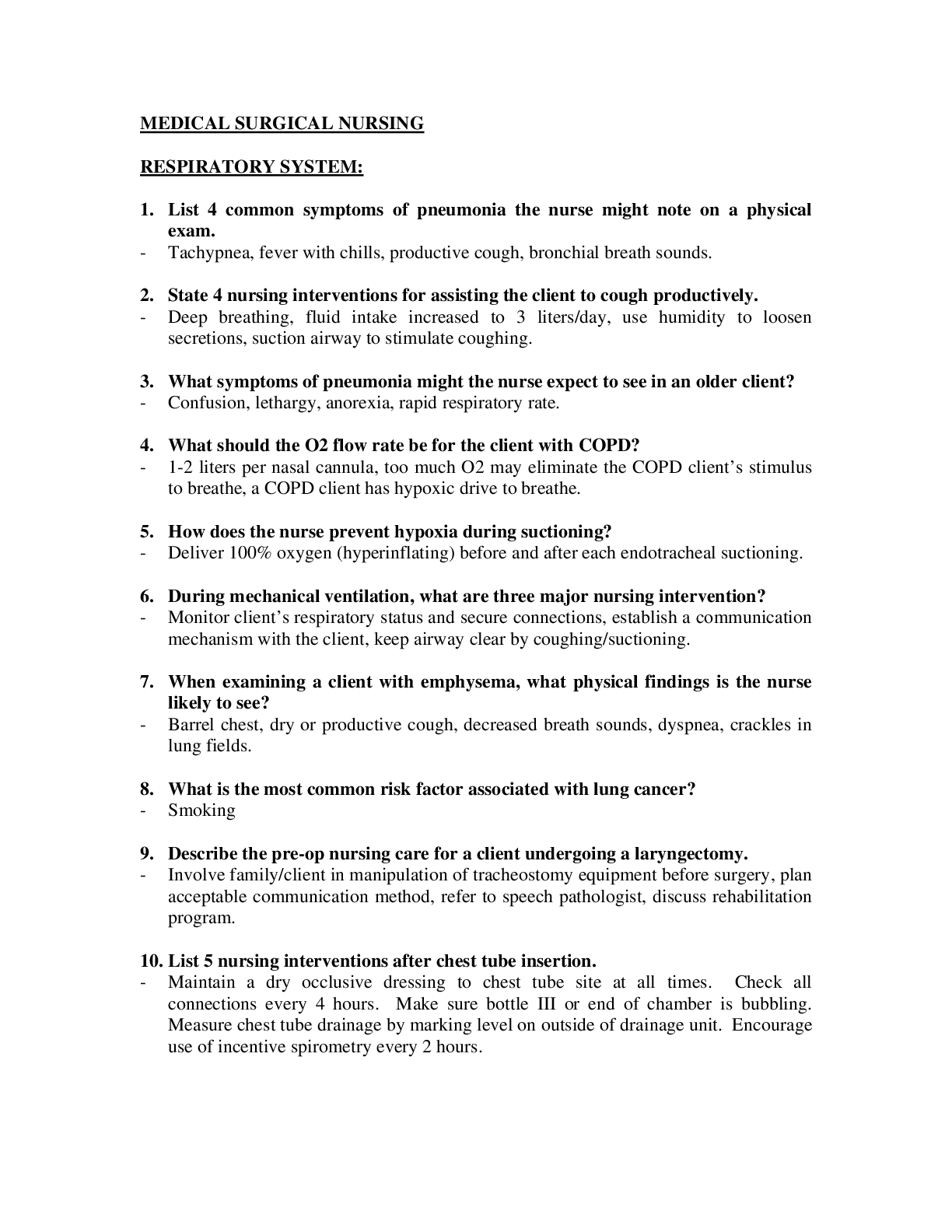
Buy this document to get the full access instantly
Instant Download Access after purchase
Buy NowInstant download
We Accept:

Reviews( 0 )
$12.50
Can't find what you want? Try our AI powered Search
Document information
Connected school, study & course
About the document
Uploaded On
Aug 27, 2020
Number of pages
15
Written in
Additional information
This document has been written for:
Uploaded
Aug 27, 2020
Downloads
0
Views
140

 - Florida International University.png)
 - Florida International University.png)
 - Florida International University.png)
 - Florida International University.png)

 Questions and answers – Keiser University.png)
